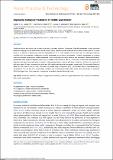| dc.contributor.author | Laizer, Alpha | |
| dc.contributor.author | Bidu, Jerome | |
| dc.contributor.author | Selemani, Juma | |
| dc.contributor.author | Njau, Karoli | |
| dc.date.accessioned | 2023-10-05T08:40:43Z | |
| dc.date.available | 2023-10-05T08:40:43Z | |
| dc.date.issued | 2022-01-01 | |
| dc.identifier.uri | https://doi.org/10.2166/wpt.2021.083 | |
| dc.identifier.uri | https://dspace.nm-aist.ac.tz/handle/20.500.12479/2123 | |
| dc.description | This research article was published by Water Practice & Technology Journal, Volume 17, Issue 1, 2022. | en_US |
| dc.description.abstract | Textile industries are among the primary contributors of water pollution. Treatment of textile wastewater is very important before discharging it to the environment. In the present study, laboratory-scale anaerobic batch reactors were used for co-treatment of a mixture of textile and domestic wastewater at 37 °C. The objective of this work was to investigate optimum conditions for the anaerobic co-digestion of textile wastewater and domestic wastewater. Domestic wastewater as a carbon source to enhance treatment of textile wastewater in color and other pollutants removal was examined. Textile and domestic wastewater were mixed at different proportions to make a total volume of 500 mL. Proportions of domestic wastewater and retention time were two main factors studied in influencing pollutant removal efficiency. Optimum conditions for removal of pollutants were 18 days' residence time at 60 and 40% textile and domestic wastewater respectively. The removal efficiencies were 52.8, 58.3 and 51.6% for Color, BOD and COD, respectively. Phosphorus (PO43−), Ammonium (NH3-N) and Nitrate (NO3-) increased at 78.5, 49 and 87% respectively. However, the concentration levels were above Tanzania Bureau of Standards (TBS) discharge limits. Post treatment is suggested to achieve standard discharge limits. | en_US |
| dc.language.iso | en | en_US |
| dc.publisher | IWA Publishing | en_US |
| dc.subject | Anaerobic treatment | en_US |
| dc.subject | Biological oxygen demand (BOD5) | en_US |
| dc.subject | Chemical oxygen demand (COD), | en_US |
| dc.subject | Domestic wastewater | en_US |
| dc.subject | Textile wastewater | en_US |
| dc.title | Improving biological treatment of textile wastewater | en_US |
| dc.type | Article | en_US |

